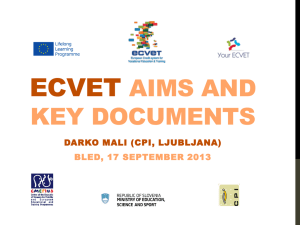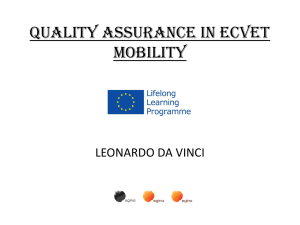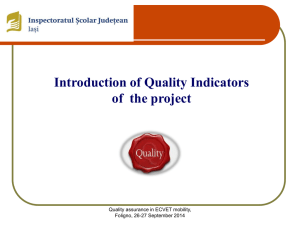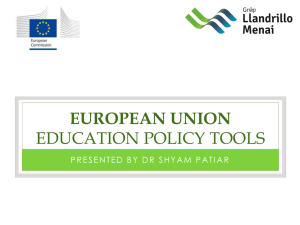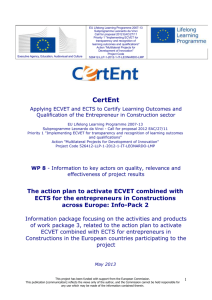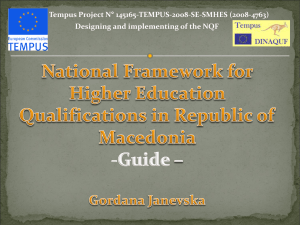ECVET points
advertisement
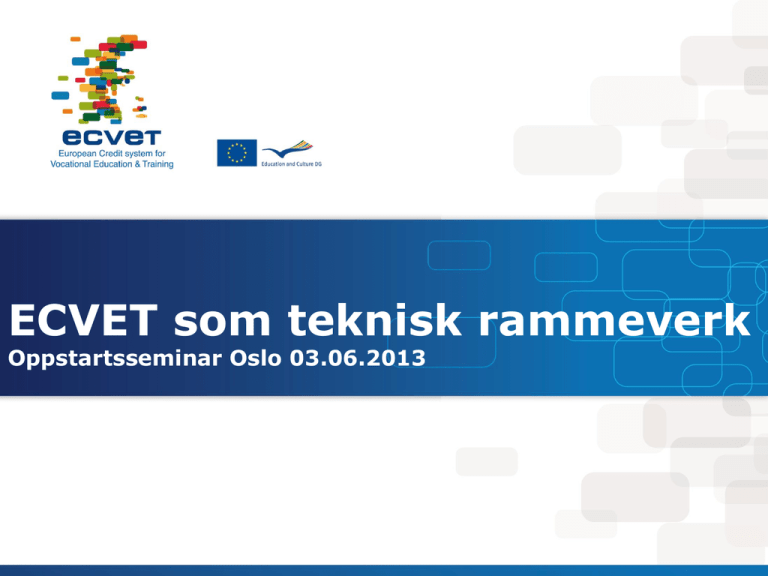
ECVET som teknisk rammeverk Oppstartsseminar Oslo 03.06.2013 ECVET Recommendation The ECVET Recommendation What is the objective? European Credit System for Vocational Education and Training (ECVET) is a technical framework for the transfer, recognition and, where appropriate, accumulation of individuals’ learning outcomes with a view to achieving a qualification. Timetable a preparatory period running until 2012, during which the Member States will be asked to create the necessary conditions and to adopt measures with a view to introducing ECVET each Member State may adopt and introduce ECVET (and also carry out tests and experiments) without waiting until 2012 a period for the gradual introduction of ECVET, running until 2014 possible revision of the European Recommendation in 2014 Technical specifications What has to be implemented? ECVET — Principles and technical specifications European policy context Policy context Europe 2020 strategy Europe 2020 is the EU's growth strategy for the coming decade. In a changing world, we want the EU to become a smart, sustainable and inclusive economy. These three mutually reinforcing priorities should help the EU and the Member States deliver high levels of employment, productivity and social cohesion. Policy context Europe 2020 strategy Strategic framework for European cooperation in education and training (”ET 2020”) Significant progress being made: in support of national reforms of lifelong learning; the modernisation of higher education; the development of common European instruments promoting quality, transparency and mobility; Strategic objectives: Making lifelong learning and mobility a reality; Improving the quality and efficiency of education and training Where do we come from? 2005: European Reference tools: EQF, ECVET, EQAVET Emphasis on collaboration between EU member states, as a basis for mobility and LLL 2002 2004 2006 2008 2010 Copenhagen Maastricht Helsinki Bordeaux Brugge 2008: EQF Recommendation 2009: ECVET/ EQAVET Recommendation EU2020: •ET 2020 •Youth on the Move •New skills for jobs 9 European initiatives and tools Synergies between LLL instruments EQAVET EQF EURO PASS ECVET NIFL Non formal and informal learning Key words • Bridge between labour market and E&T system • Flexible learning pathways between education & training systems • Validation of nonformal / informal learning Lifelong learning Transparency Mobility Permeability • Flexible learning pathways within education & training systems European Credit System for Vocational Education and Training (ECVET) is a technical framework for the transfer, recognition and, where appropriate, accumulation of individuals’ learning outcomes with a view to achieving a qualification. Transnational mobility Lifelong learning R e c o g n i t i o n Learning outcomes Transparency of qualifications Transfer process Accumulation process ECVET objectives and technical components Transnational mobility Lifelong learning R e c o g n i t i o n Transparency of qualifications Learning outcomes Transfer process Units of learning outcomes ECVET points Assessment of learning outcomes Accumulation process Validation of learning outcomes Recognition of learning outcomes Memorandum of understanding (partnership) Learning agreements Transcript of record ECVET technical specifications Learning outcomes Learning outcomes are statements of what a learner knows, understands and is able to do on completion of a learning process and which are defined in terms of knowledge, skills and competence Learning outcomes Increases consistency between the European tools (as they all follow this approach); Linking the occupational and the educational standards used for the definition of qualifications and VET learning processes, and, at a macro level, education and the labour market; Introducing a common language; Clarifying the relationships between different forms and contexts of learning; Raise discussion on the input-based perspective to education, training and qualifications purely based on location, duration and/or teaching methods and call for dialogue on the relevance and quality of qualifications. Units of Learning Outcomes A unit is a component of a qualification, consisting of a coherent set of knowledge, skills and competence that can be assessed and validated Identify what learners can learn Describe the learning outcomes that the learner is expected to achieve It’s feasible what is to achieve The credit to this unit can be recognised Process: transfer and accumulation of learning outcomes 18 Units in relation to qualifications Depending on the existing regulations, units may be common to several qualifications or specific to one particular qualification Small units Advantages Units can be obtained in a rather short period of learning and therefore are particularly suitable for geographical mobility They can also be suitable for adult learners who combine learning and employment or learners who are at risk of dropping out from longer programmes Disadvantages Because of the greater number of units in a qualification, this approach implies putting in place a large number of assessments Fragmentation of qualifications and of assessments may make it more difficult to identify whether the learner can combine all the knowledge, skills and competence in a more complex manner Large units Advantages Assessment of a larger unit enables learners to demonstrate their capacity to combine knowledge, skills and competence in view of delivering a more complex service or a product The number of summative assessments is small Disadvantages More substantial amount of learning activities is required to prepare for a unit. Hence it may be difficult to achieve a full unit in the context of a short transnational mobility period The duration of learning activities preparing for the unit may be too substantial for learners outside initial VET to be able to benefit from accumulation Credit and ECVET point What is the difference between ECVET points and credit? ECVET points are not to be confused with credit. Credit designates the learning outcomes the learner has achieved. ECVET points provide information about the qualification and the units. Credit is transferred and accumulated. ECVET points provide information about the credit the learner has transferred and accumulated. ECVET points Allocation of ECVET points to a QUALIFICATION is based on a convention according to which 60 points are allocated to the learning outcomes expected to be achieved in a year of formal full time VET Allocation of ECVET points to a UNIT is based on its relative weight within the qualification The relative importance of the unit LOs for labour market, for progressions to other qualification levels of for social integration The complexity, scope and volume of the unit LOs The effort necessary for a learner to acquire the knowledge, skills and competence required for the unit Transfer and accumulation of learning outcomes 1 Host provider Learning agreement The individual acquires KSC 2 Sending provider 3 The learning outcomes are assessed Credit is awarded for the individual learning outcomes achieved 4 Learning outcomes are 7 recognised and accumulated as part of the intended qualification, corresponding ECVET points are included 6 Learner’s credit in a individual transcript of record 5 Credit is validated Transfer and recognition of learning outcomes Memorandum of Understanding (MoU) Host provider Sending provider Learning agreement 7 1 The individual acquires KSC 2 Learning outcomes are recognised and accumulated as part of the intended qualification, corresponding ECVET points are included 3 The learning outcomes are assessed Credit is awarded for the individual learning outcomes achieved 6 4 Credit is validated Learner’s credit in a individual transcript of record 5 Learning agreement Learning agreement Agreement at operational level Operational framework for mobility exchanges More detailed information about the qualifications concerned, the mobility exchange and the conditions for assessment, validation and recognition of credit The decision on who needs to sign such an agreement would also depend on the responsibilities of different actors within the qualifications system What is a Memorandum of Understanding? A MoU is an umbrella agreement A MoU is an agreement between competent institutions which sets the framework for credit transfer It formalises the ECVET partnership by stating the mutual acceptance of the status and procedures of competent institutions involved It also establishes partnership’s procedures for cooperation Potential benefits of ECVET LO Employability Mobility Flexible pathways Validation NFIL Units Transfer accumulation recognition ECVET points Qualifications system Conception functions in VET (F1) (F2) Design of Design of qualifications formal or nonformal programmes Realisation functions in VET (F3) Design of assessment/ validation process and procedures (F4) Carrying out the formal or non-formal programme (F5) Assessment of learning outcomes (formal, non-formal and informal) Transversal function (F8) Quality assurance and regulation (F6) Validation of learning outcomes (formal, non-formal and informal) (F7) Certification/ recognition of learning outcomes (including the award of qualification, certificate, diploma…) Design of ECVET elements (F1.1.) Description of qualifications in terms of units of learning outcomes (F2) Link between units of learning outcomes and the formal or non-formal programme (F1.2.) Allocation of ECVET points to qualifications and to units Use of ECVET for accumulation and Transfer (F3) Link between assessment/ validation processes, the achievement of units of learning outcomes and award of associated ECVET points (F4) Practical use of learning outcomes and credit for mobility (F5.1.) Establishment of Learning agreements (F5.2.) Assessment of learning outcomes and award of corresponding credit (F6.1.) Recording of assessed learning outcomes and credit in the personal transcript (F6.2.) Validation of learning outcomes and of corresponding credit Award of corresponding ECVET points to the learner Transversal functions (F8) Establishment of Memoranda of Understanding (all actors may be involved in establishment of a MoU directly or by delegation) (F9) Provision of Information, its Documentation and Communication (F10) Funding and governance (F7) Recognition of learning outcomes and process for taking credit into account for the award of qualification (i.e. transfer and accumulation)
